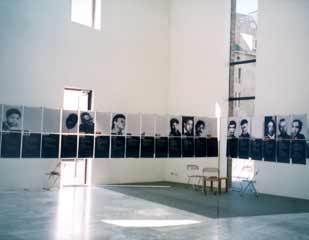
Many were killed, because the right-extremist mindset doesn’t allow them a place in society, some, because they had the courage to stand up to Nazi slogans. Some fates stirred public sympathies, many were barely even noticed, most forgotten. This exhibition calls on us to remember these individuals.
The exhibition is based on publicly accessible information, principally newspaper articles. Rebecca Forner initiated the work on the exhibition in autumn 2000, after a chronicle memorializing 93 victims of right-wing violence since 1990 was published by the daily papers »Frankfurter Rundschau« and »Tagesspiegel«. The chronicle ignited a political battle, because the State Interior Ministry had only registered 24 murdered from right-wing violence during the same timeframe.
The extent of systematic denial was relatively conspicuous when the Ministry did not even take note of Farid Guendoul’s death. Farid Guendoul, an Algerian asylum seeker, was chased through Guben, a small town near the Polish border, by eleven right-extremists in February 1999. He died from his injuries. The »Guben Hunt« made headlines throughout the country, but because the offenders were only charged with »bodily injury caused by negligence,« there was officially no victim. In May 2001 the Federal and State Interior Ministries changed their assessment system of right-wing crimes. The new assessment criteria should make it possible to correct past mistakes. Yet in 2007 the federal government still only registered 40 cases dating back to 1990 as motivated by right-wing ideology.
Many of those dead never made the headlines, and no statistics bear witness to their fate. The exhibition remembers these people and at the same time, addresses the issue of the ongoing denial of right-wing violence.
»If I Don’t Intervene, I Become an Accomplice« – A Conversation with Rebecca Forner
The politically active graphic artist was a member of anti-Fascist initiatives and studied Communications Design at the School of Art and Design Berlin-Weißensee. She worked on the exhibition »Victims of Right-Wing Violence« from 2000 to 2004. In 2002, her work was publically shown for the first time at the Berlin memorial site »Topography of Terror«, the former location of the Gestapo Headquarters. Rebecca Forner lives in Bilbao.
What gave you the idea of creating an exhibition about victims of right-wing violence?
The idea surfaced in autumn 2000 during my studies at the School of Art and Design Berlin-Weißensee. In a course by Professor Alex Jordan, we discussed possibilities for combating right-extremist violence through politically engaged graphic arts. The chronicle of victims, which was published around this time, gave me the idea of visually documenting the victims. Without using too many words, I wanted to depict the reality that must be faced in the struggle against the right-wing.
How did you research information about the victims?
The chronicle by Frankfurter Rundschau and Tagesspiegel was the basis for my research. In addition, I looked at newspaper articles from the past ten years in the Anti-Fascist Press Archive in Berlin. I found more lists online and in left-wing publications. I compared these sources and gradually compiled them together.
How did you gather the victims’ pictures?
I found most pictures in tabloids. What I didn’t do was contact the families of the deceased. I didn’t want to simply call and ask for a picture. Besides, I understood clearly from the beginning that I would not find all the pictures, and I would consequently need to find a way to express these voids.
Where pictures were missing, you used gray grids as a surface…
Yes, I wanted to find a visual shape that would express the absence of the pictures, and also the reaction to the experiences I had. One of many experiences was when I wrote to the German Press Agency dpa, requesting 115 pictures of individuals. They wrote me that they only had pictures of two people, because most of the pictures were what they referred to as temporary circulation pictures. That means they aren’t archived.
Why did you place mirrors and postcards between the victims’ pictures?
It is important to me that these murders don’t become viewed as detached from the social situation. We are all involved whether we want to be or not. I chose the postcards arbitrarily, because the murders happened everywhere.
So, it’s not just about giving the victims a face. You also want to challenge the social context in which they became victims?
For me, it was completely about giving the victims recognition. But I think that this form of remembrance is also problematic. I don’t know what people reflect on when they look at these dead people, or if they even reflect. I think it is legitimate to ask uncomfortable questions, they are uncomfortable for me too.
What do you mean by that?
I am absolutely convinced that I must help if someone is being attacked. I also know that I would be afraid if I were confronted with this kind of situation. If I
intervene, I am in danger of being attacked myself. If I don’t intervene, I make myself an accomplice. This contradiction troubles me and I want the visitors to reflect on it too.
The interview was held on 20 June 2004 in Berlin.
archiv Rebecca Forner, Tagesspiegel, Victims